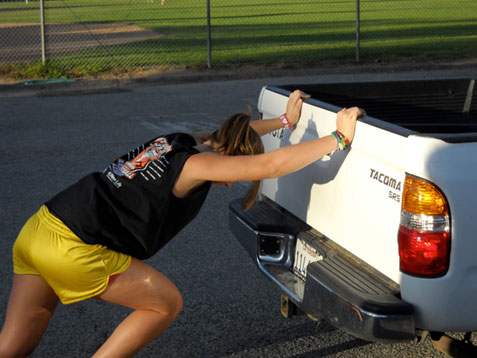
Source: Pushing a Truck, Performance Strength Training Santa Barbra
Have you ever been assigned a chapter to read for homework? After you finish you may think to yourself, "That was a lot of work!" You might be surprised to learn that in the scientific sense, reading a chapter is not work at all!
In science, work is defined as the action that results when a force causes an object to move in the direction of the force. While reading the chapter, you may have put a lot of mental effort into reading, but you were not using force to move an object. Therefore, in the scientific sense, you were not doing work.
Work in the scientific sense is a hard concept for many people to understand. You know that work is done if the following two conditions are met:
The first condition is easy to determine. In order for work to be done, an object has to move because of the force applied to it.
Look at the picture below. Is work being done?

Source: Pushing a Truck, Performance Strength Training Santa Barbra
If the truck never moves, then work is not being done. It does not matter how much force the girl applies or how hard she tries to push the truck. If it does not move, no work is done from the scientific point of view.
The second condition is a little harder to determine. In order for work to be done, the object must move in the same direction as the force being applied to it. Examine the picture below of the man carrying the boxes. Is work being done? To determine if work is being done, you must determine the direction of the force and the direction of the motion. Click on the "Check Your Answer" to see the direction of the force and the direction of the motion.
![]() Look at the following pictures, and determine if work is being done. In all the pictures assume that the object is in motion. Click on the arrow that represents the direction of force and the direction of motion in each picture and click if work is being done or not.
Look at the following pictures, and determine if work is being done. In all the pictures assume that the object is in motion. Click on the arrow that represents the direction of force and the direction of motion in each picture and click if work is being done or not.
Sources of images used in this section as they appear, top to bottom: